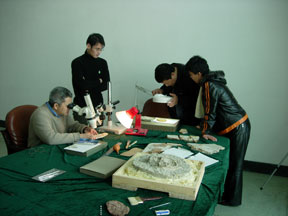
The Mesozoic mammal fossil record is dominated by fragmentary jaws and isolated teeth. These inform phylogenetic hypotheses and inferences of feeding ecology, but cranial, postcranial, and soft tissue remains are key to unraveling the phylogenetic relationships, morphological evolution, and ecology of early mammals (e.g., Ji et al 2002). Conditions necessary for such fossil preservation while rare did occur in the Early Cretaceous of northeastern China. Exquisite fossils from this lagerstätten preserve feathers of dinosaurs and birds, fur of mammals, buds of flowering plants, and wings of dragonflies.
 |
| Luo, Wang, Meng, and Gao study Early Cretaceous mammal specimens at the Dalian Museum. |
In 2006, we began studying several mammal specimens from these deposits in northeastern China. Their cranial and postcranial details provide new data for phylogenetic and functional morphological analyses that shed light on evolutionary trends and ecological specializations of Mesozoic mammals (Gao et al., 2010). To read a popular account of this research, click here. To see a CT movie of the new 'amphilestid' triconodont Juchilestes liaoningensis, click here.
Collaborators: Zhe-Xi Luo, Wang Xuri, Gao Chunling
Publications: Gao, Chun-ling, G.P. Wilson, Z.-X. Luo, A.M. Maga, Q. Meng, and X. Wang. 2010. A new mammal skull from the Lower Cretaceous of China with implications for the evolution of obtuse-angled molars and “amphilestid” eutriconodonts. Proceedings of the Royal Society B: Biological Sciences 277:237-246.
